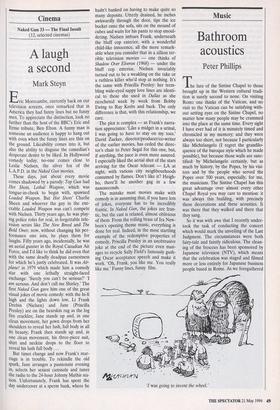Music
Bathroom acoustics
Peter Phillips
he lure of the Sistine Chapel to those brought up in the Western cultural tradi- tion is surely second to none. On visiting Rome one thinks of the Vatican, and no visit to the Vatican can be satisfying with- out setting eyes on the Sistine Chapel, no matter how many people may be crammed into the place at the same time. Every sight I have ever had of it is minutely timed and chronicled in my memory; and they were always too short, not because I particularly like Michelangelo (I regret the grandilo- quence of the baroque style which he made possible), but because those walls are sanc- tified: by Michelangelo certainly, but as much by history, by the Popes, by his visi- tors and by the people who served the Popes over 500 years, especially, for me, the musicians. The Sistine Chapel has this great advantage over almost every other Chapel Royal you may care to mention: it was always this building, with precisely these decorations and these acoustics. It was there that they walked and there that they sang.
So it was with awe that I recently under- took the task of conducting the concert which would mark the unveiling of the Last Judgment. The circumstances were both fairy-tale and faintly ridiculous. The clean- ing of the frescoes has been sponsored by Japanese television (NTV), which meant that the celebration was staged and filmed more or less entirely for Japanese business people based in Rome. As we foregathered 'I was going to invent the wheel.' to rehearse in that inimitable space we were confronted not so much with the tech- nicalities of how Palestrina or Allegri might have encouraged their singers to perform the very works we were about to broach, but by explaining to some excessively polite but uncomprehending people that Salve Regina was not the name of the composer and that, yes, we would like to use the famous ‘barcony' (as the Japanese plan of the building expressed it) from which the Chapel choir has normally sung for some several hundreds of years now. Nonetheless the concert was broadcast live on RAI Uno, for all that the only Italians in the audience were a handful of cardinals.
One of the less complicated aspects of the job was that I had to stand for hours looking at the Last Judgment (the singers, of course, had their backs to it). Much has been written about the restoration of this fresco. If anything you may have read has implied that the power of Michelangelo's vision has been reduced by the recent cleaning, then the writer in question has an agenda all of his own. The painting does not look as it did, in several significant respects, but the impact and meaning of it can never have been greater. Whether one particularly warms to the sight of the damned being received into hell (such chunky, irresistible people) in the brightest colours is one question; but, even for the insouciant, Michelangelo's newly-projected imagery is overwhelming. I twice lost my place during the concert; and when I finally caught sight of the green snake chewing at the pudenda of that Vatican official whom Michelangelo has especially disliked, just over the door at the bottom right-hand side, I laughed aloud. If you guard a fond memory of that more polite Michelangelo, colours muted, limbs subtly shaded, loin- cloths in place, which we all grew up with, abandon it now. The reality is as uncom- promising as the work of a modern painter you've never heard of and suspect you don't like much.
For those of my colleagues who have wondered, as I did for many years, what the sound is really like in that Chapel which spawned so many masterpieces, the answer is bathroom, but bathroom of a highly individual type. The best place for sound is from the balcony or choir-gallery, since the heavy wooden screening which surrounds it and its elevation about twelve feet off the ground cause any singing from inside to be slightly masked. But from wherever it may be produced in that place sound merges so seamlessly with the acous- tics that I found it impossible to tell when the actual singing had stopped and the building had taken over. I watched the musicians' lips with as much fascination as any follower of George Bush, unable to believe that they had stopped the sound when all the visual evidence confirmed that they had: the more surprising since very reverberant buildings tend to distort sound early in its flight. This is the secret of the Sistine Chapel acoustics: the tuning is per- fectly preserved while the chords acquire the most beautiful roundness. I have never 'heard anything so lovely (it is less effective when full of people) finding I had to invent special tempi to make the most of it.
One could get hooked on experiences like these; which would be a pity, since the people who watch over the Pope's private chapel are extremely reluctant to let any- body else make use of it. Perhaps, as with the Allegri Miserere they once had to themselves, they would like to heighten its reputation by giving it scarcity value. Inci- dentally, how did Mozart get in there, as a youth, that day he heard the Allegri and copied it out afterwards from memory? I don't believe it would be possible today.





































































 Previous page
Previous page